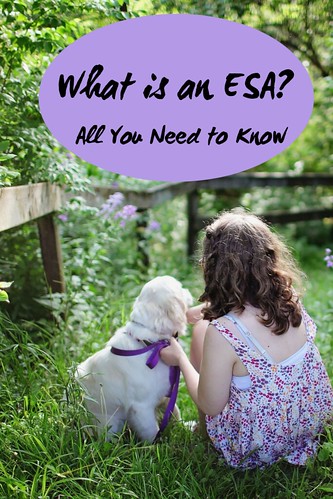For people suffering from mental or emotional disabilities or illness, an emotional support animal (ESA) can provide support, comfort and unconditional love. Approximately 25% of Americans suffer from some form of mental or emotional malady. Many studies have shown that the companionship of a dog or cat can be of great therapeutic benefit.

What is an ESA?
An ESA, or emotional support animal, is a pet declared to be of therapeutic benefit to an individual suffering from a mental or emotional disability. An ESA provides its owner with comfort, support, love, and companionship. This can go a long way in easing anxiety, social anxiety, post-traumatic stress disorder (PTSD), depression, and more.
An ESA is not specifically trained to carry out tasks for their owner. Thus, it is not granted access to places of public accommodation, such as hotels.
How Do You Qualify for an ESA?
To qualify for an ESA, you need to be diagnosed with an emotional disability. This diagnosis must be given by a licensed mental health practitioner (LMHP). The gamut of emotional disabilities includes:
• Social anxiety
• Anxiety
• Post-traumatic stress disorder (PTSD)
• Phobias
• Depression
• Bipolar Depression
To find out if you qualify for an ESA, you can take the quick 5-min Certapet pre-screening questionnaire!
An ESA Letter. What is all the Fuss About?!
To magically turn your adorable pet into an ESA super hero, all that you need is an ESA letter. This letter, written by a LMHP, on their letterhead should include the following:
• The type of license that your LMHP carries.
• The date of the license.
• The license numbers.
• The state of issue.
• The date when the letter was written.
The ESA letter must contain confirmation:
• That you are a current patient of the signing LMHP.
• That you are under the care of this LMHP, being treated for the specified disability.
• That you are significantly limited in performing or participating in at least one of life’s major activities because of your condition.
• An ESA is being prescribed as a central part of the treatment for your current condition.
Do You Need to Certify Your ESA?
No, definitely not! The letter from your LMHP is all that you need. You do not need to register or certify your support pet anywhere. Beware! There are several fake support and registration sites out there claiming that you need to register or certify your ESA.
Can You Buy an ESA dog or ESA cat?
No, an ESA is not like a service dog in that it comes equipped to be an ESA. Most dogs, in their integral nature have what it makes to be an ESA. What makes the dog or cat an ESA is the letter, which is specific to the pet owner and not the pet.
Which Animals are Best Suited to be ESAs?
Almost any animal can be considered an ESA. Anything from dogs and cats to squirrels and stick insects! You are perfectly entitled to love and treasure your star-nosed mole, but it might not be so well-received on a flight from NY to Miami! Most therapists will only recognize dogs, cats, and the occasional rabbit as a suitable emotional support animal.

Dogs Make Great Emotional Support Animals!
They are not called ‘man’s best friend’ without good reason! Emotional support dogs are the most common type of emotional support animal. For centuries, dog and man have been mutually co-dependent. Dogs have a unique way of tapping into our souls and lifting our spirits.
Some dog breeds are better suited for the prime position of ESA. For example, Retrievers, German Shepherds, and Poodles. Yet, there is no legal need for an emotional support dog to be of any specific breed. In fact, mixed breed dogs make for super ESAs. They usually have a deep understanding of others’ suffering while being both calm and gentle.
Can Kitty Cat Cuddles Help?
Emotional support cats are a real thing!! Those soothing purrs and lap-warming sessions are total soul food. Some breeds of cat are more suited to a role as an ESA than others, for example, the Norwegian Forest cat, American Shorthair, and Maine Coon. Once again, though it is entirely up to the pet owner about what works the best for them.

Other Potential Emotional Support Animals?
Rabbits, mice, squirrels, pigs, snakes, horses… the list goes on. There is no strict rule outlining which animals can and cannot be ESAs. Yet, there is a limit as to which types of animals can be granted the privileges that go along with being classed as an ESA. Most travellers would not feel so comfortable if the passenger seated beside them was accompanied by their emotional support snake!! Equally, can you imagine boarding Delta flight 1049 with your emotional support pony in tow! There are limits to both the practicality, and the safety and hygiene of different animal species.
What are the Benefits of Having an ESA?
There are any number of benefits to having an ESA as part of your therapeutic treatment. The different boons will depend on the individual and their needs.
1. Companionship. Your ESA is a devoted, loyal and non-judgmental companion.
2. An ESA can reduce anxiety. Either by being a reliable presence when you are at home or by being a buffer when you are out and about.
3. Your ESA can help to reduce stress levels. This can be by encouraging you to get out of doors to take your doggo for a walk. Thus, letting off some steam and getting some fresh air!
It could also be by simply being a presence in your home. So that you don’t stress about being alone or vulnerable.
Spending time with your furry friend will cause the release of endorphins and other happy hormones. Rhythmic petting of your dog or cat is comforting for both you and your pet. Thus, reducing both anxiety and/or depression.
4. Distraction. Your ESA can help to keep your mind off troublesome and worrying thoughts. This, in turn, will help you to relax and sleep better. Which, in turn, will better equip you to deal with the stresses next time around.
5. Lessens Isolation. Having an emotional support dog gives you the opportunity to socialize and interact with fellow dog walkers in the park.
Is an ESA a Therapy Dog? Is an ESA a Service Dog? What is the Difference?
An emotional support animal is neither a therapy dog, nor a service animal.
Training the Difference
For people suffering from mental or emotional disabilities or illness, an emotional support animal (ESA) can provide support, comfort and unconditional love. Approximately 25% of Americans suffer from some form of mental or emotional malady. Many studies have shown that the companionship of a dog or cat can be of great therapeutic benefit.
A therapy dog also undergoes training. However, this training is not as arduous. A therapy dog accompanies its handler (usually its owner) on visits to places such as hospitals, care homes or schools. The therapy dog will comfort the sick and/or elderly. Or, it could sit patiently by while a child with learning challenges learns to read out loud.
Beyond basic obedience training, an emotional support dog requires no training.
Who Goes Where?
Another difference between ESAs, therapy animals, and service animals is the transport and accommodation privileges that they enjoy. Due to the nature of the role that they play, service dogs are allowed in most public places as they accompany and assist their humans. Therapy animals are only allowed to enter public spaces such as hospitals, hospices and schools where they will be doing their therapy work!
On condition of the Americans with Disabilities Act (ADA), ESAs are granted two privileges in this regard
1. The Fair Housing Act
According to the Fair Housing Act (FHA), an emotional support animal can be viewed as a “reasonable accommodation” in a house or flat that has a no pets’ policy. This act protects people from being discriminated against because of their disability. ESA owners are legally allowed to keep their support animal with them, even in a building designated as a no-pet zone. Owners of ESAs are exempt from paying pet fees or additional pet deposits.
2. The Air Carrier Access Act
The air carrier access act (ACAA) provides the legal requirements to ensure that individuals with disabilities in need of an ESA are not discriminated when traveling by plane. The ACAA allows people with a legitimate emotional support animal to travel in-cabin with them by plane without incurring an extra fee. No airline is allowed to refuse transportation to an individual or their ESA should they have the correct documentation.
How Do You Get an ESA?
You might already have a beloved pet that fulfils many of the roles that an ESA does. In that case, all that there is to do, is to see whether you qualify for an ESA and get an ESA letter. The Certapet 5-min pre-screening is a quick way to answer that question for you.
Or, you might find yourself truly identifying with what you have read here and want to investigate getting a dog or a cat as an ESA. Once you have an ESA letter in hand, you can start your search for a canine or kitty companion of your very own!

Adopting is a Great Way to Finding the Perfect ESA!
There are many many dogs and cats sitting in shelter homes waiting to find their furever homes. Do you fancy a purebred pup? There are plenty of breed-specific rescue groups that will be able to help you find the perfect canine companion.
There are several advantages to choosing a rescue pet
1. You know what you are getting. A fully-grown dog or cat will not yield any surprises about its size or shape. Their personality is already established. Shelter dogs are assessed to make sure that they are not dangerous.
2. By adopting a dog or a cat, you are giving it a second chance at a great life. This can be a very healing and rewarding process for the both of you!
3. Rescue pets have usually seen their share of misfortune. They are, therefore, that much more understanding of your troubles. They are more in tune to when you need reassurance and comfort.
4. Mixed breeds are generally less demanding with regards to exercise and training needs.
What to Look for in a Reputable Breeder?
Do you have your heart set on getting a brand-new puppy or kitten? Make sure to do your due diligence when selecting a breeder to buy your new furry friend from. Some things to take into consideration:
1. The breeder must be eager to answer any and all questions that you have about the breed and their breeding stock.
2. You should ask to see health certification for conditions such as hip and/or elbow dysplasia (large and giant breeds), and progressive retinal atrophy (PRA).
3. Be sure to look for a conscientious breeder, committed to breeding only the healthiest and most well-rounded animals.
4. The breeder’s premises should be clean and hygienic. To raise well-balanced animals, they should allow the pups and kittens to be a part of family goings-on in the home.
5. The breeder should not breed with a bitch before she is at least two years old. A dam should not have puppies two seasons in a row.
Where Do You Find an ESA?
In short, anywhere where you can find an animal! If you are looking for a breeder of a specific dog breed, the American Kennel Club website is a good place to start. The Cat Fanciers Association has a list of breeders for specific cat breeds. To find out about animals looking to be re-homed, you can ask at your local animal shelter or rescue group. Your local vet and/or pet shop might have a notice board. Check there for information about pets looking for new homes, or litters of puppies or kittens for sale.

